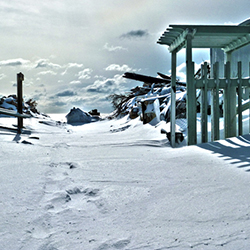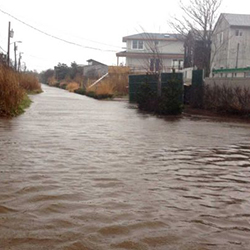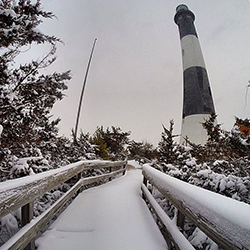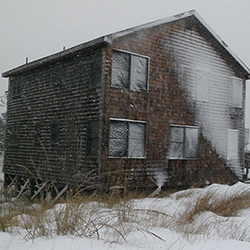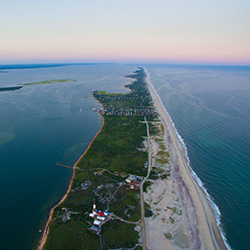Shoshanna McCollum
Friday, November 16:
“We are will not be able to move back into our home before winter John. I was hoping you’d come to the realization on your own, but you haven’t. Let’s please figure out a plan before winter sets in.” Hash words but they had to be said. Now the undamaged winterized house up the street I had been urging him to look into had just been rented by someone else. “Honey, those people no longer have a home,” John replied in a maudlin tone. “WE DON’T HAVE A HOME!” I snapped back in disgust. This charade could go on no longer. I have been sleeping in a tiny unheated room with spinach green walls on the goodwill of a woman who was getting a little tired of seeing us in her house after more than three weeks now. I lack empathy. I do not want to hear about the damages to anybody else may have suffered at this point. I only care about protecting me and my own.
Sunday, November 18:
A FEMA caseworker called us, Finally! The woman sounded a little disorganized and scattered as she asks if she could see us the following day.
“I have an appointment that morning in Co-PAY- gee at 9 in the morning, so how ‘bout I meet you at 10?”
Her sad mispronunciation of Copaigue gave away that she’s not from Long Island among other things.
“Are you aware that you have to take a ferry out to Fire Island to see me in Ocean Beach?” I ask.
“Can I bring my car on the ferry?”
“Sorry, no.”
“Can I see you Thursday then?”
“Thanksgiving? Sure, if you’re working why not?”
She pauses…
“Tell you what, I broke my back windshield. I’ve got to take care of that, can I call you later?”
Wednesday, November 21:
I call to follow-up with the FEMA caseworker. Now that FINS permit civilian driving allowed again John is agreeable to meeting her on the mainland and driving her over here to expedite our case. She tells me bluntly that she is no longer assigned to us. If she isn’t who is? No answer, but about an hour later John sees a team of FEMA workers canvassing our street. I rush out to meet them. The team is comprised of three ladies meticulously leaving flyers in the door jams of houses, not unlike Jehovah’s Witnesses. I catch their attention and give her the case number I’ve been assigned. Can they help? Not really because these ladies were dispatched for the sole purpose of dispersing flyers. How did they manage to make the ferry while that caseworker could not? “But you have a case number and that’s great!” one of them says in a chipper tone.
Thursday, November 22 :
Thanksgiving Day: It is a beautiful, warm sunny day. Almost a waste, this would have been a good working day. All of us had plans for this holiday that got derailed. The Thanksgiving table is comprised of me, John, Betsy, Betsy’s cousin Richie Stretch, Richie’s wife Barbara and our neighbor Frank Fischer. Betsy has been preparing this meal all morning and is in a bad mood now. No one is very hungry. We pick at the food and the conversation is awkward. I find a bottle of red wine on the table, drink too much of it and go upstairs to my tiny room and sleep most of the day away.
Friday, November 23:
“I’m going to turn the water off upstairs this weekend,” Betsy says to me in a frank tone. “Sorry I’ve kept it on as long as I could, but I can’t have my pipes freezing.” Who can blame her? When there was no electricity, Betsy’s health condition meant she needed us almost as much as we needed her. It was a reciprocal arrangement. Like I said to John last week, we’ve got to figure out a plan.
Saturday, November 24:
Since our spat last week John has been working on the house at a feverish pitch. It’s a nervous energy, which concerns me. Some moments we are like newlyweds again as this storm has brought us closer, but that closeness means we’ve been arguing a lot as well. Still, there’s been progress. We have four safe power outlets in service, our propane heater survived the storm undamaged, plus a couple up the street also offered us a used convertible sofa bed that’s still in great shape. With partial power, heat and a bed we can live in one room as we rehabilitate the others. To keep us in the mindset of moving back I buy a set of sheets when we go shopping on the mainland. With electricity we work into evening hours at the house and I cook us up a super with some canned provisions the Salvation Army brought over earlier in the week. The meal is bland and uninspiring. That evening we receive a phone call from a fellow we know who announces that God has instructed him to come to Fire Island to “help us.” When I try to calmly say this may not be a good idea, he utters a rant of swears and obscenities, then concludes the call with the blessing “Namaste” before hanging up. This disturbing call creates tension and soon John and I burst into a huge argument again. These fights are often about silly things, but there are always seething issues right beneath the surface. I storm out of the house and back to Betsy’s where I sit on the couch beside her and stare blankly at the television with me face burning and throat dry. “The two of you have been at it again?” she asks with her evening cocktail in hand. “Yup,” I say. “He has to leave, but you can stay here as long as you need to.”
Sunday, November 25:
Dreading seeing John that morning, I put off going to the house as long as I possibly can. However soon he is standing at the bedroom door. “I’m sorry about last night, – I was looking forward to a nice evening together,” he says grimly. “Goodie is sick. He vomited early this morning and now won’t wake up.” This sounded serious. Kittens vomit all the time, but when it is followed by lethargy our experience is that it can mean death within 24 hours. Our cats survived the storm, but there is still so much toxic stuff on the ground that caries risk. Goodie the dominant kitten who ventured out into the nor’easter to retrieve his runt littermate. How often had we seen the bigger, stronger kitten be the one to fall? When I get there his brother Sapho and Sun Spot, an elder male who has taken a liking to Goodie are sitting vigil by his side as he is curled in a ball sleeping deeply. My mind is somewhere else when we get a phone call from another FEMA representative. This fellow sounds a little brighter than the last one. He has arranged several Fire Island appointments, recruiting the homeowners with driving permits to form a chain of rides so he can see each one of us in a timely fashion, which we gladly oblige. That evening John arrives with a sandwich for us to split for super. As I unravel the wrapping I suddenly see a black furry torpedo flying in the direction of the kitchen table. It’s Goodie! Smelling the deli meat, he eats it greedily as I share scraps with him. He’ll be just fine.
Monday, November 26:
There is a phase that is repeated often in the FEMA handbook: that a home should be “safe and sanitary” in order to be fit for occupation. Part of me feared we would not be allowed to move back home again. Even on a good day, long before this storm ever hit it is fair to say that John and I had lived an eccentric lifestyle. Now there are cats napping inside our inoperable refrigerator. It looks like we are staring in the “Ma and Pa Kettle” movie remake. The man arrives well scrubbed and speaks in a quick measured clip. In attempt to look presentable I toned down my Christmas sweater with a clean flannel shirt that a high school friend in Massachusetts sent to me in a care package of thrift shop items. I have tried to comb my braids evenly and hope they don’t look too greasy. John offers him a cup of brewed coffee, which he accepts. I take this as a good sign. “This is really good coffee,” the caseworker remarks. It’s true John makes excellent coffee. Then most uncharacteristically, Cutie, our meanest and fattest cat rubs her large round head against the caseworker’s knuckles as he enters data into a tablet device. He takes some measurements and asks us a few questions. “FEMA will offer you lodging in a hotel if you feel you need it,” he advises us in a gentle voice and mildly amused expression. John drives him over to his next appointment and returns with the sofa bed. Progress suddenly moves at a frenzied pace. A few hours later our living room has been transformed into a Spartan, efficiency not unlike a studio apartment in New York City. We still lack the basic comforts of a refrigerator or hot water but the cats all pile into bed with us that night and it is clear we have been missed.
Tuesday, November 27:
John is driving Betsy to a doctor’s appointment today and my goal is to pack up our things and leave the room spotless. It has become dingy during the weeks that we stayed with her. How two people who lost most of their possessions manage to clutter the room with so much stuff is a little mind-boggling. I gather clothing that now includes a wardrobe of thrift shop garments as well as the airdropped fluffy pink bathrobe that I’ve become very fond of. At the beginning of this stint I found this tiny room with its creamed spinach colored walls very depressing. But every morning I watched the birds feed on an overgrown bush of bittersweet that encroaches upon the roof and felt safe here. Hard to believe that only a month ago today I was wearing a witch costume at Castaway’s Halloween party and the Reggae singer was performing there singled me out by taking my hand to dance with him. Over the past weeks I sometimes resented pithy inquiries that were more self-serving than actual concern for my welfare. However now I realize that this bitterness was just a mask for my sorrow when there was dead silence. How a single voice from the outside world might have given me courage when I felt frightened and alone in the dark, but some are so frugal such gestures cannot be spared. So I take comfort in the people who stayed on this island with me, knowing we will share a bond forever. The last item to load on the wagon is my rain boots, but I suddenly realized they really stink of bay sludge and the sweat of my feet. So in a last minute decision I threw them out in the garbage.

